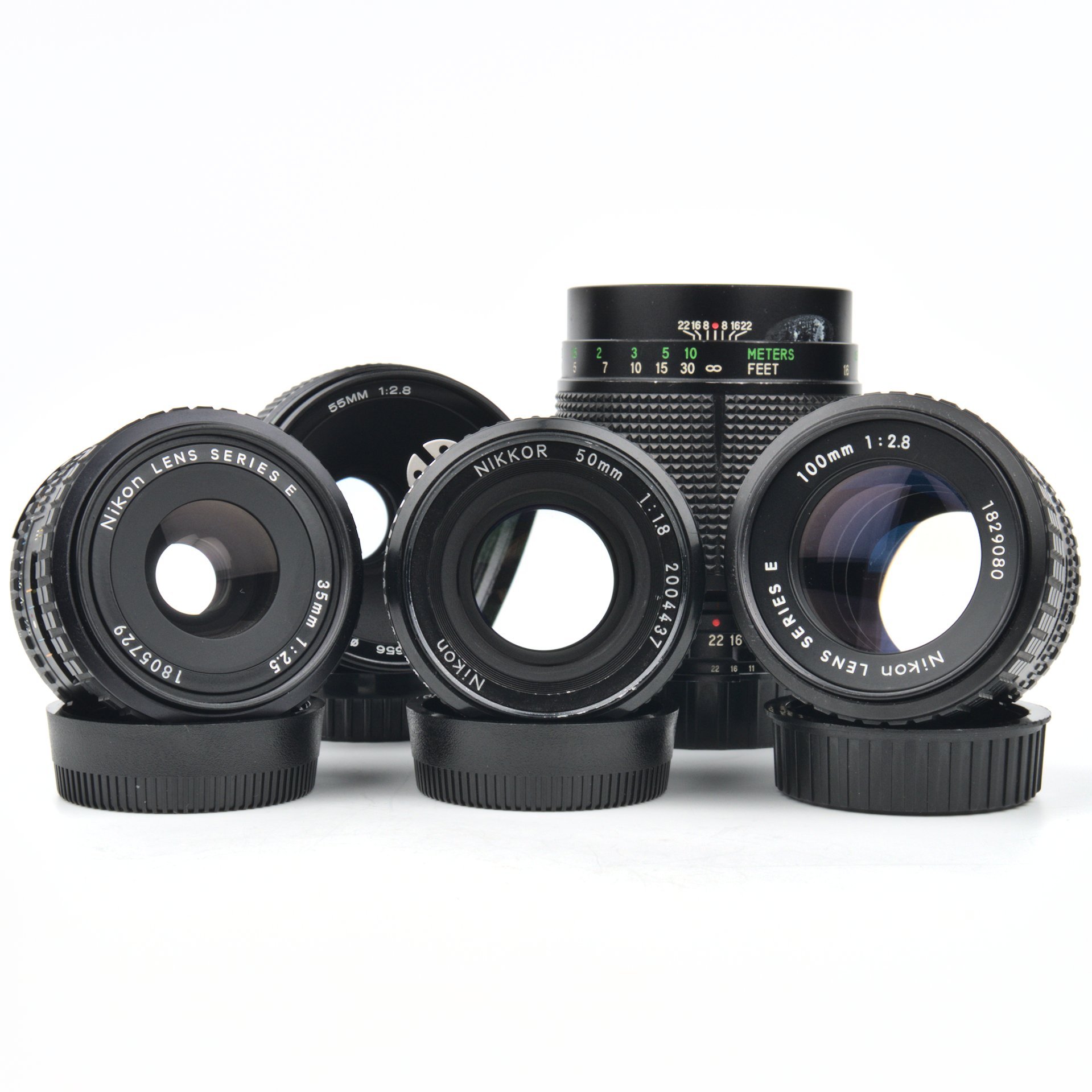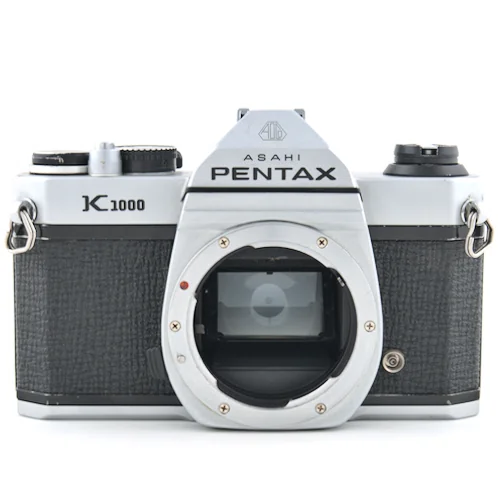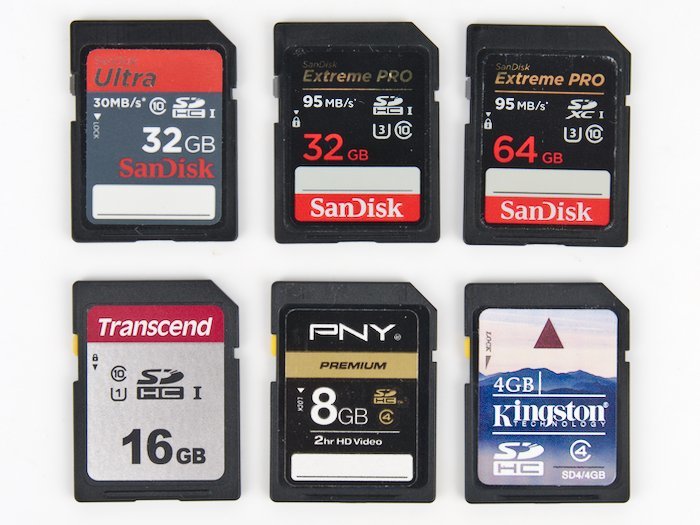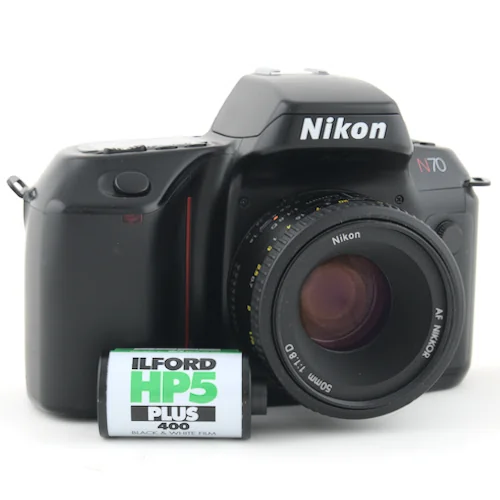
Unlocking the Magic of the Nikon FE2 with Classic Lenses
- Nathaniel Stephan
- Nikon f mount camera , Nikon fe2 , 35mm film camera
- October 6, 2024
Table of Contents
Pair the Nikon FE2 with the right lens and you’ll get to experience the 1980’s magic the camera is known for.
It is compatible with AI F-mount lenses. Earlier “non-AI” lenses can damage the camera’s mount if force is used to get them to mount.
I am going to recommend compatible lenses that are lightweight, small, and fun to use. This comes with the benefit that most of them are easy to find and inexpensive.
The “professional lenses” can be brutal on price. Manual focus F-mount lenses are easy to adapt to any mirrorless system with a cheap adapter.
Affiliate Advertising Disclosure
Outside the Shot is a participant in the Amazon Services LLC Associates Program, an affiliate advertising program designed to provide a means for sites to earn advertising fees by advertising and linking to Amazon.com.
As an eBay Partner, I may be compensated if you make a purchase. I also participate in affiliate advertising programs with KEH and Adorama. More can be found on the Affiliate Disclosure page.
- Kit Lens - Nikon 50mm f/1.8 Series E
- Wide Angle Lens - Nikon Nikkor 24mm f/2.8 Ai
- Portrait Lens - Nikon 100mm f/2.8 Series E
- Zoom Lens - Vivitar Series 1 70-210mm f/3.5
- Macro Lens - Vivitar 90mm f/2.8
Non Ai vs Ai and Ai-S Lenses
The early Nikon cameras used a Meter Coupling Prong. The Nikon FE2 uses a Meter Coupling Ridge.
Lenses built around the time when Nikon moved to Ai lenses can have both forms of meter coupling.
Compatible AI, AI-S, AF, and AF-D lenses will have a notch cut out of the aperture ring by the mount. AF and AF-D lenses will need to be switched into manual mode.
Non-AI lenses do not have a notch. They will only have a Meter Coupling Prong. Attempting to mount one onto the FE2 will be difficult and can cause damage.
Nikon F-mount lens and camera compatibility covers this in more detail.
Standard Prime Lens
What you see, is what will show up framed when you look into the viewfinder. Focal lengths around 50mm are going to closely resemble your field of view.
If you are new to film photography, this will make your life easier. You won’t have to be walking, bobbing, weaving, squatting, or performing other athletics to get the camera into a spot to frame things correctly.
These were “kit lenses” that would be sold with new cameras. That’s why there are so many options.
Nikon 50mm f/1.8 Series E
https://www.outsidetheshot.com/nikon-f//nikon/nikon-50mm-f18-series-e.jpg does not exist- Get the second version with the chrome ring
- Fits in a pocket
- Take abuse well
- 52mm filter threads
See current price and more information on:
One of the best MF’ing (manual focusing) lenses for street and casual use. It’s the perfect lens to leave on your camera, so it’s always ready to go.
If you don’t already have one, a great lens for the FE2 is the Nikon 50mm f/1.8 Series E. The 50mm f1.8 is really easy to find, has excellent image quality, is cheap, small, and lightweight.
Be sure to get the second version of the lens, that has a chrome ring around the body of the lens. It is made of aluminum, whereas the first version is made from plastic.
The 50mm Series E lens is often referred to as a pancake lens because of its small size. When mounted on the FE2 the lens barely sticks out. This is very useful for keeping the camera under a jacket so that you can keep a low profile.
Nikon Nikkor 50mm f/1.4
https://www.outsidetheshot.com/nikon-f//nikon/nikon-50mm-f14.jpg does not exist- Superb optics.
- Optical multi-coatings to reduce chromatic aberrations.
- Many copies are available.
- Comparatively low-priced.
See current price and more information on:
The Nikon Nikkor 50mm f/1.4 is 2/3 of a stop faster, at the increased cost of size and weight. It is slightly higher priced than any of the f/1.8 or f/2 lenses.
Voigtländer Nokton 58mm f/1.4 SL II AI-S
https://www.outsidetheshot.com/nikon-f//nikon/voigtlander-nokton-58mm-f14-sl.jpg does not exist- Outstanding optics.
- Has a Meter Coupling Prong.
- CPU Contacts.
- Available for purchase new.
See current price and more information on:
Nikon produced a 55mm f/1.2 and 50mm f/1.2, but the cost to performance is bad. As a consequence of the age of the lenses, you need to be concerned about the grease in the focusing helicoid drying up, ruining the experience of using the lens.
The Voightlander 58mm f/1.4 is overall a superior choice for a premium quality lens. The focusing ring is the smoothest| I have ever used on a manual focus lens. The lens is am absolute delight to use.
Additionally, the lens provides compatibility that spans all F-mount SLR cameras. The lens has a CPU contacts, Ai Meter Coupling Ridge, Meter Coupling Prong, and has a switch for electronic aperture control. You can switch the lens from a Nikon 35mm film SLR to a Nikon DSLR seamlessly.
Alternatives
- Nikon Nikkor 50mm f/1.8
- Nikon Nikkor 50mm f/2
- Nikon 35mm f/2.5 Series E
- Nikon 28mm f/2.8 Series E
Wide Angle Lens
Nikon Nikkor 24mm f/2.8
https://www.outsidetheshot.com/nikon-f//nikon/nikon-24mm-f28.jpg does not exist- Great paired with a 50mm lens.
- Optical multi-coatings to improve performance.
- Many copies are available.
- Comparatively inexpensive.
See current price and more information on:
The Nikon Nikkor 24mm f/2.8 is a good choice for a wide-angle lens. It is well suited for architectural or landscape photography.
There are loads of wider focal lengths to select from, but they are often are much more expensive or show significant amounts of barrel distortion. Third-party lenses have clearly decreased image quality than lenses made by Nikon.
Nikon 28mm f/2.8 Series E
https://www.outsidetheshot.com/nikon-f//nikon/nikon-28mm-f28-series-e.jpg does not exist- Great when used with a 50mm lens.
- Optical multi-coatings to improve performance.
- Easy to find.
- Easily affordable.
See current price and more information on:
A inexpensive option, the Nikon 28mm f/2.8 Series E, is on the border of being a wide-angle lens. It is attractive to use with the FE2 because of the low price and ease that the lens can be found.
Alternative Wide Angle Lenses
In terms of price, the correlation is straightforward. The larger the field of view, the pricier the lens will likely be. Faster versions also go for a whole lot more.
- Nikon 8mm f/2.8 Fisheye
- Nikon Nikkor 15mm f/3.5
- Nikon Nikkon 18mm f/3.5
- Nikon Nikkon 24mm f/2
- Nikon Nikkon 13mm f/5.6
- Nikon Nikkon 16mm f/2.8 Fisheye
- Nikon Nikkon 20mm f/2.8
Portrait & Telephoto Lens
Nikon 100mm f/2.8 Series E Lens
https://www.outsidetheshot.com/nikon-f//nikon/nikon-100mm-f28-series-e.jpg does not exist- 85mm alternative.
- Excellent price to performance.
- Comparatively low-priced.
- Easy to find.
See current price and more information on:
85mm focal length lenses weren’t as commonly used as they are today compared to when the FE2 was first released in 1983. 100mm or 135mm focal lengths were more prevalent because of their cheaper price.
Just like all of the other Series E lenses mentioned, the 100mm f/2.8 hits an excellent balance of usability, price, andcapabilities. That’s why the lens was popular when introduced and why a great number of copies are readily available on the used market.
Nikon Nikkor 135mm f/2.8 Lens
https://www.outsidetheshot.com/nikon-f//nikon/nikon-135mm-f28.jpg does not exist- 85mm substitute.
- “Vintage” portraiture rendering.
- Many copies are available.
See current price and more information on:
The “classic” look of this lens is produced by the focal length combined with the lens only containing 4 elements.
The first version of the lens was released in 1965. A total of 6 versions of the lens, only the last two being suitable for the FE2.
If you go looking for a copy of the lens, the compatible lenses will be listed as Ai-S or Ai.
Alternative Telephoto Lenses
There is no shortage of additional telephoto lenses to pick from. The 85mm lenses and focal lengths longer than 135mm will be highly-priced.
| Nikkor 85mm f/2 | Nikkor 105mm f/1.8 |
| Nikkor 105mm f/2.5 | Nikkor 135mm f/2 |
| Nikkor 135mm f/2.8 | Nikon 135mm f/2.8 Series E |
| Nikkor 180mm f/2.8 | Nikkor 200mm f/2 ED |
| Nikkor 300mm f/2 IF-ED | Nikkor 300mm f/2.8 |
| Nikkor 300mm f/4.5 | Nikkor 400mm f/2.8 IF-ED |
| Nikkor 500mm f/4 IF-ED P | Mirror Nikkor 500mm f/8 |
| Nikkor 600mm f/4 IF-ED | Nikkor 800mm f/5.6 IF-ED |
Nikon FE2 Zoom Lenses
Before cameras had autofocus, in the early 1980’s, there were several lenses made by third-party manufacturers that were optically better than Nikkor lenses.
Some of these lenses were released under the Vivitar brand name. Any lens that has the Vivitar Series 1 branding on it is going to have terrific optics.
Vivitar Series 1 70-210mm f/3.5
https://www.outsidetheshot.com/nikon-f//nikon/vivitar-70-210-f35.jpg does not exist- Covers a useful zoom range.
- Good for portrait or wildlife photography.
- A rare example of when a third-party lens is the best.
See current price and more information on:
Alternative Zoom Lenses
Unfortunately, shorter focal length zoom lenses have issues making them a undesirable option to use with the Nikon FE2. Age along with wear and tear has caused many Nikon zoom lenses to become borderline unusable.
The single lens I would suggest looking for is the Vivitar Series 1 VMC 35-85mm f/2.8 (Also found on KEH). , the lens can be difficult to come across.
Vintage Zoom Lens Problems
The lens that should be the leading recommendation, the Nikon Zoom-Nikkor 35-105mm f/3.5-4.5, is regrettably, a push-pull zoom. Rather than having having a zoom ring, the focus ring is pushed or pulled to control the zoom range.
The grease in almost all of these lenses has broken down to the stage where the zoom mechanism will not support itself. Because of this, the lens will have small changes in focal length when trying to focus the lens. This is going to be made worse if the lens is pointed up or down.
Nikon Macro Lenses
Komine manufactured the two recommended macro lenses in Japan. The lenses were also sold under numerous brand names. Rokunar, Elicar, Spiratone, Quantaray, and Panagor are brands that also sold the lenses.
There is a Vivitar 90mm f/2.8 Macro Lens Review and a Vivitar 55mm f/2.8 Macro Lens Review.
For capturing images at macro magnification (1:1), the 90mm lens will be the superior pick because it has a larger working distance.
The 55mm lens is excellent for table-top and close-up photography.
Vivitar 90mm f/2.8
https://www.outsidetheshot.com/nikon-f//nikon/vivitar-90mm-f28-macro-lens.jpg does not exist- My favorite vintage macro lens.
- Was produced in a variety lens mounts.
- Awesome value.
See current price and more information on:
Vivitar 55mm f/2.8 Macro Lens
https://www.outsidetheshot.com/nikon-f//nikon/vivitar-55mm-f28-macro-lens.jpg does not exist- The second best vintage macro lens I’ve used.
- A fantastic choice for close-up photography.
- Can achieve 1x magnification without needing an extension tube.
See current price and more information on:
Alternative Macro Lenses
- Nikon Micro Nikkor 55mm f/3.5
- Lester A Dine 105mm f/2.8
- Micro Nikkor 105mm f/2.8
Used Nikon Camera Lens Prices
Lens prices change all the time as they are influenced by availability and interest in manual focus lenses. Over the past several years, film photography was going through an increase in popularity, which has caused prices to increase.
Economic conditions are constantly changing, and unanticipated developments can quickly lead to changes in prices. Even so, the difference in prices between lenses should stay similar.
Check out a few sites to get a good idea of what market prices look like. If you are fortunate enough to come across a great deal, purchase it quickly, because the best deals are short lived.
What Lens Mount Does the Nikon FE2 Use?
The Nikon FE2 has an Nikon F-mount. Introduced in 1959, the F-mount is still in use today. Over time changes have been made to add autofocus, CPU contacts, metering information, and electronically controlled apertures.
Use manual focus lenses listed as either Ai-S or Ai with the FE2. Those lenses are built with a meter coupling ridge which will allow the camera to accurately meter light.
For an explanation of the differences between lenses, this page explains everything Nikon F-mount lens and camera compatibility.


